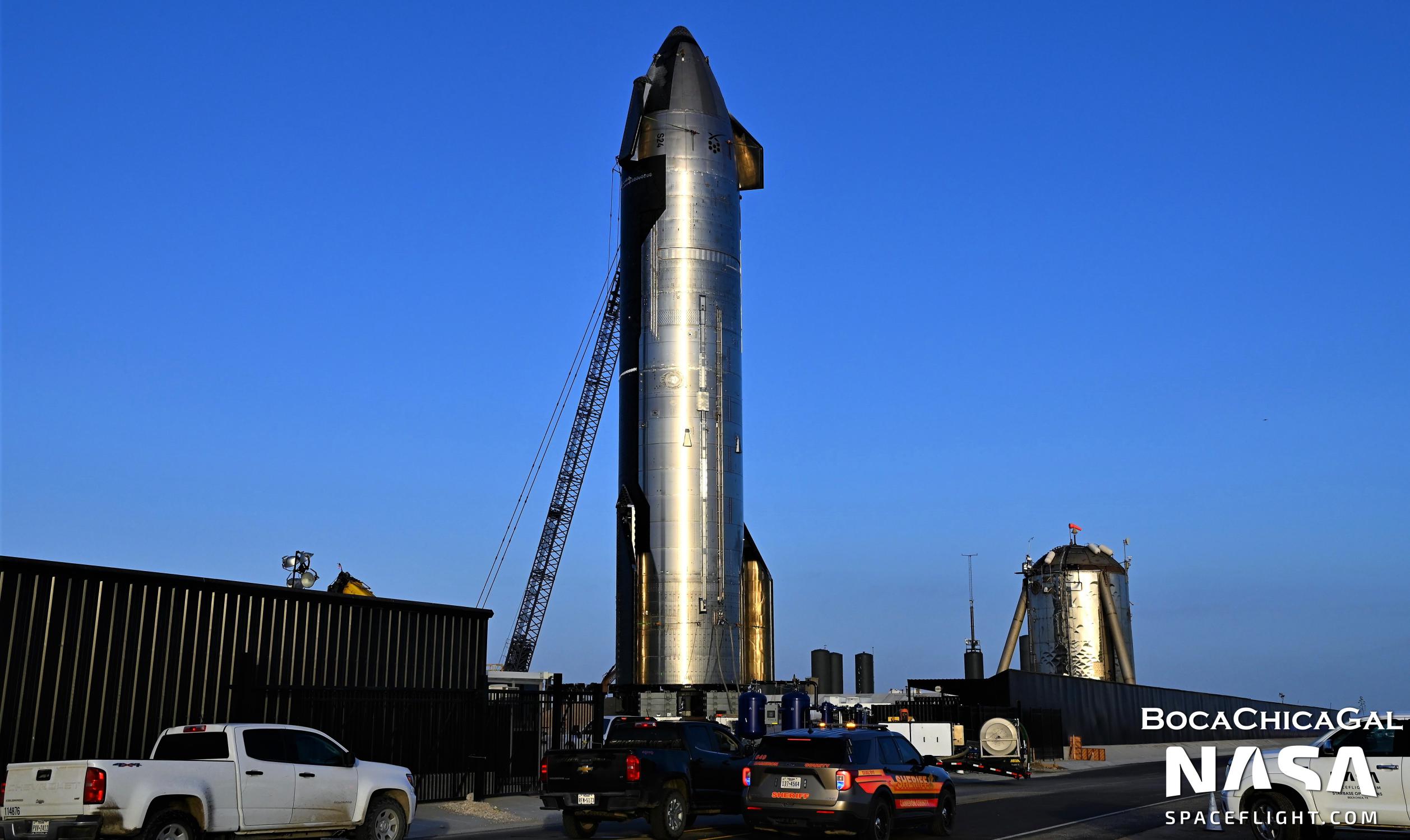
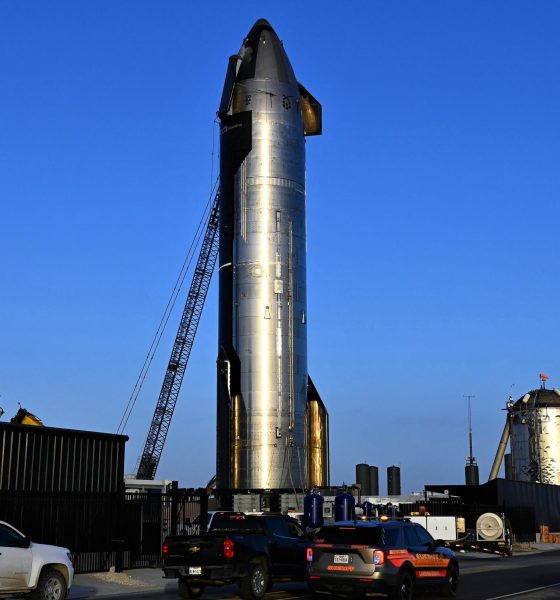
News
SpaceX sends Starship prototype to launch pad after engine installation
After several weeks of work back at SpaceX’s Starbase rocket factory, the company has transported a new and improved Starship prototype to nearby test and launch facilities, where it joined a similarly upgraded Super Heavy booster.
That Starship prototype – Ship 24 or S24 – is closely following in the footsteps of Super Heavy Booster 7 (B7), which kicked off a similar phase of preflight testing about two weeks ago. The purposes of their latest trips from the factory to the launch pad are also largely the same and could potentially open the door for Starship’s inaugural orbital launch attempt sometime later this year if the process goes smoothly. Both protypes have a ways to go, however.
Booster 7 and Ship 24 got off to fairly rocky starts when they began a less risky phase of proof testing in May and June. Apparently caused by improper sequencing or a small design flaw, a large steel tube meant to carry liquid methane fuel through Booster 7’s liquid oxygen tank and double as a storage vessel for landing propellant violently imploded when a vacuum formed inside it. It took SpaceX several weeks to repair the damage but, defying the odds, the tube was eventually repaired and Booster 7 completed another two proof tests soon after.
A few weeks later, during one of Ship 24’s first tests, a much smaller internal pipe – likely carrying high-pressure gas – also failed, damaging heat shield tiles and other adjacent plumbing. S24’s troubles were less dramatic and only took a few days to fix, but both were still new failure modes for the Starship program and served as a reminder that Starship hardware remains relatively immature and that SpaceX is still learning. Nonetheless, they also demonstrated SpaceX’s ability to respond quickly to new problems, as both B7 and S24 sailed through additional testing without apparent issue after quick repairs.
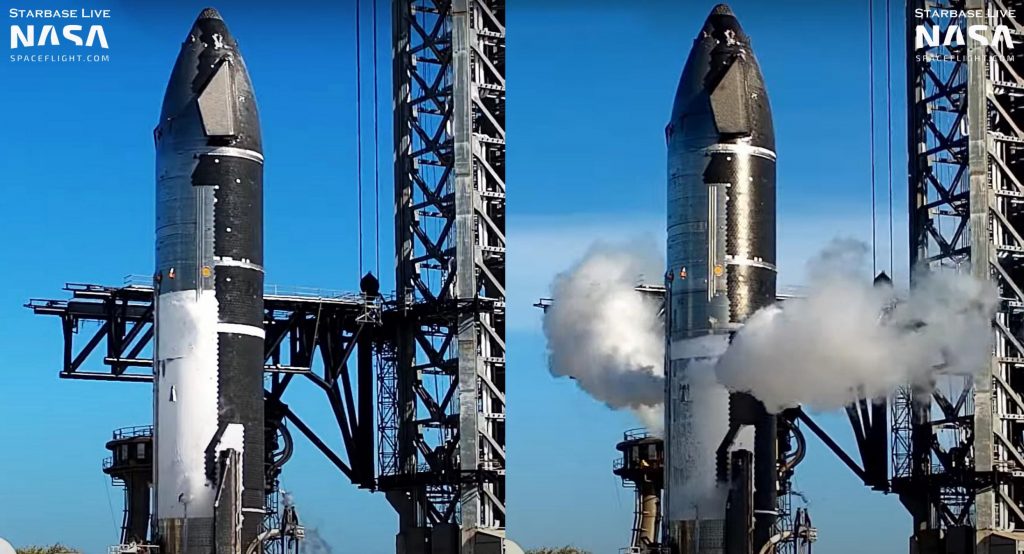
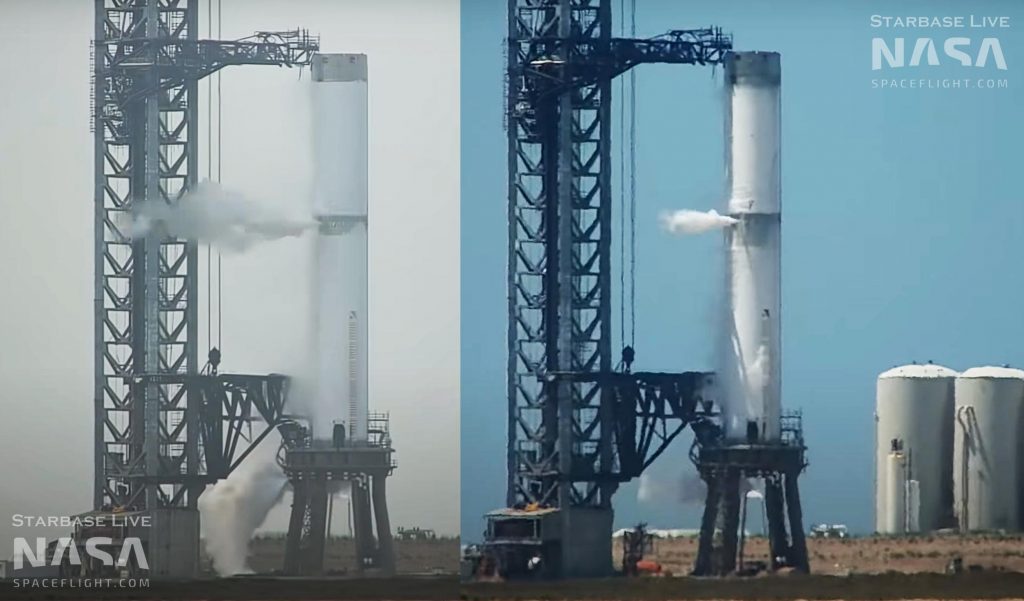
After completing cryogenic proof and thrust simulation testing, B7 and S24 returned to SpaceX’s factory facilities for Raptor installation and finishing touches. SpaceX took about six weeks to install 33 Raptor engines and associated heat shielding on Booster 7, while installing six Raptors and wrapping up a few other aspects of Ship 24 took about four weeks.
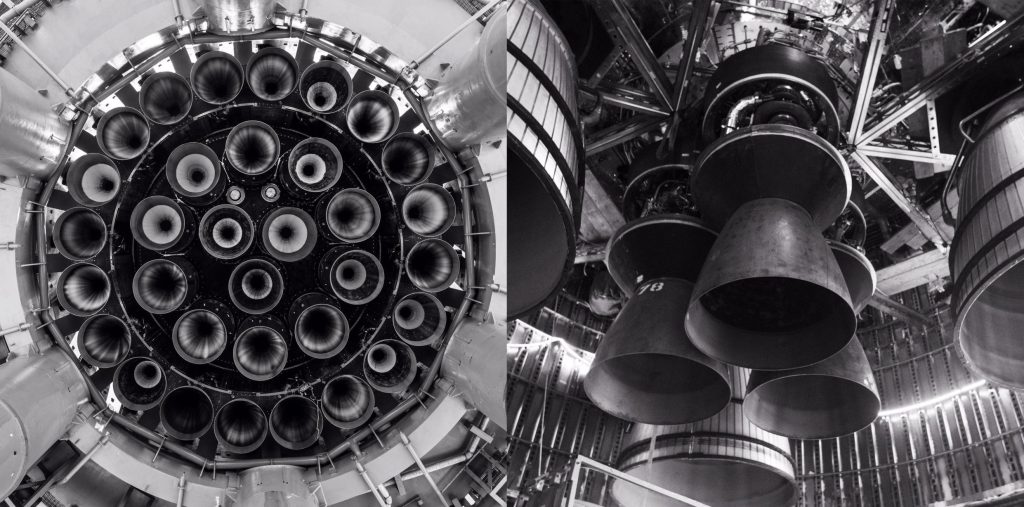
Aside from the installation of most of the Starship’s missing heat shield tiles, Ship 24’s preparations did include one particularly unique step involving its payload bay prototype. SpaceX’s first stab at a Starship payload bay has been likened to a giant Pez dispenser, which is not entirely inaccurate. Exclusive to Starlink, satellites will be stored on a rectangular rack that’s assumed to operate like an elevator. As an unknown mechanism pushes two satellites at a time through Starship’s slot-like bay door, the stack of satellites will feed downwards like bullets in a magazine until the full set is fully deployed.

In late June, SpaceX attached a giant white box to a crane and positioned the box to interface with Ship 24’s bay door, where it hung for the better part of a day. The test confirmed speculation that the box was meant to solve perhaps the most obvious problem SpaceX’s unique payload bay design posed: payload installation. SpaceX’s solution appears to involve using the deployment mechanism in reverse, with the white box conveying Starlink Gen2 satellites through the ‘slot’ and the dispenser grabbing and lifting each pair up into the bay.
It’s possible that Ship 24 will have a handful of Starlink V2/Gen2 satellites loaded into its bay if it passes its next tests. Before being cleared for flight, Ship 24 will need to complete at least one nominal wet dress rehearsal (simulating every aspect of a launch short of engine ignition) and one six-engine static fire, though several tests are far more likely. Starship S24’s test campaign will benefit significantly from Starship S20, which survived extensive testing (and multiple six-Raptor static fires) in 2021. In comparison, Super Heavy B7’s similar wet dress rehearsal and static fire test campaign will be almost entirely new to SpaceX, save for a single three-engine static fire completed by an outdated booster prototype last year.
SpaceX could attempt to static fire Booster 7 for the first time as early as Wednesday, July 6th. It’s unclear if the company will attempt to kick off Ship 24’s next round of testing in the gaps between Super Heavy B7’s static fire testing. While unlikely, SpaceX is technically capable of testing Ship 24 and Booster 7 simultaneously.

News
Tesla Full Self-Driving gets sparkling review from South Korean politician
“Having already ridden in an unmanned robotaxi, the novelty wasn’t as strong for me, but it drives just as well as most people do. It already feels like a completed technology, which gives me a lot to think about.”

Tesla Full Self-Driving got its first sparkling review from South Korean politician Lee So-young, a member of the country’s National Assembly, earlier this week.
Lee is a member of the Strategy and Finance Committee in South Korea and is a proponent of sustainable technologies and their applications in both residential and commercial settings. For the first time, Lee was able to utilize Tesla’s Full Self-Driving technology as it launched in the country in late November.
Her thoughts on the suite were complimentary to the suite, stating that “it drives just as well as most people do,” and that “it already feels like a completed technology.”
드디어 오늘, 서울에서 테슬라 FSD 체험 했습니다.
JiDal Papa님의 모델S 협찬에 힘입어^^ 파파님 정말 감사합니다.
국회 -> 망원시장 -> 홍익대 -> 국회 복귀 코스였고요.
이미 무인 로보택시를 타봐서 그런지 신기함은
덜했지만, 웬만한 사람만큼 운전을 잘하네요.이미 완성된 기술이라고… pic.twitter.com/8pAidHBpRG
— 이소영 국회의원 (Soyoung Lee) (@im_soyounglee) December 17, 2025
Her translated post says:
“Finally, today I got to experience Tesla FSD in Seoul. Thanks to the Model S sponsored by JiDal Papa^^, I’m truly grateful to Papa. The route was from the National Assembly -> Mangwon Market -> Hongik University -> back to the National Assembly. Having already ridden in an unmanned robotaxi, the novelty wasn’t as strong for me, but it drives just as well as most people do. It already feels like a completed technology, which gives me a lot to think about. Once it actually spreads into widespread use, I feel like our daily lives are going to change a lot. Even I, with my license gathering dust in a drawer, don’t see much reason to learn to drive a manual anymore.”
Tesla Full Self-Driving officially landed in South Korea in late November, with the initial launch being one of Tesla’s most recent, v14.1.4.
It marked the seventh country in which Tesla was able to enable the driver assistance suite, following the United States, Puerto Rico, Canada, China, Mexico, Australia, and New Zealand.
It is important to see politicians and figures in power try new technologies, especially ones that are widely popular in other regions of the world and could potentially revolutionize how people travel globally.
News
Tesla dispels reports of ‘sales suspension’ in California
“This was a “consumer protection” order about the use of the term “Autopilot” in a case where not one single customer came forward to say there’s a problem.
Sales in California will continue uninterrupted.”

Tesla has dispelled reports that it is facing a thirty-day sales suspension in California after the state’s Department of Motor Vehicles (DMV) issued a penalty to the company after a judge ruled it “misled consumers about its driver-assistance technology.”
On Tuesday, Bloomberg reported that the California DMV was planning to adopt the penalty but decided to put it on ice for ninety days, giving Tesla an opportunity to “come into compliance.”
Tesla enters interesting situation with Full Self-Driving in California
Tesla responded to the report on Tuesday evening, after it came out, stating that this was a “consumer protection” order that was brought up over its use of the term “Autopilot.”
The company said “not one single customer came forward to say there’s a problem,” yet a judge and the DMV determined it was, so they want to apply the penalty if Tesla doesn’t oblige.
However, Tesla said that its sales operations in California “will continue uninterrupted.”
It confirmed this in an X post on Tuesday night:
This was a “consumer protection” order about the use of the term “Autopilot” in a case where not one single customer came forward to say there’s a problem.
Sales in California will continue uninterrupted.
— Tesla North America (@tesla_na) December 17, 2025
The report and the decision by the DMV and Judge involved sparked outrage from the Tesla community, who stated that it should do its best to get out of California.
One X post said California “didn’t deserve” what Tesla had done for it in terms of employment, engineering, and innovation.
Tesla has used Autopilot and Full Self-Driving for years, but it did add the term “(Supervised)” to the end of the FSD suite earlier this year, potentially aiming to protect itself from instances like this one.
This is the first primary dispute over the terminology of Full Self-Driving, but it has undergone some scrutiny at the federal level, as some government officials have claimed the suite has “deceptive” naming. Previous Transportation Secretary Pete Buttigieg was vocally critical of the use of the name “Full Self-Driving,” as well as “Autopilot.”
News
New EV tax credit rule could impact many EV buyers
We confirmed with a Tesla Sales Advisor that any current orders that have the $7,500 tax credit applied to them must be completed by December 31, meaning delivery must take place by that date. However, it is unclear at this point whether someone could still claim the credit when filing their tax returns for 2025 as long as the order reflects an order date before September 30.

Tesla owners could be impacted by a new EV tax credit rule, which seems to be a new hoop to jump through for those who benefited from the “extension,” which allowed orderers to take delivery after the loss of the $7,500 discount.
After the Trump Administration initiated the phase-out of the $7,500 EV tax credit, many were happy to see the rules had been changed slightly, as deliveries could occur after the September 30 cutoff as long as orders were placed before the end of that month.
However, there appears to be a new threshold that EV buyers will have to go through, and it will impact their ability to get the credit, at least at the Point of Sale, for now.
Delivery must be completed by the end of the year, and buyers must take possession of the car by December 31, 2025, or they will lose the tax credit. The U.S. government will be closing the tax credit portal, which allows people to claim the credit at the Point of Sale.
🚨UPDATE: $7,500 Tax Credit Portal “Closes By End of Year”.
This is bad news for pending Tesla buyers (MYP) looking to lock in the $7,500 Tax Credit.
“it looks like the portal closes by end of the year so there be no way for us to guarantee the funds however, we will try our… pic.twitter.com/LnWiaXL30k
— DennisCW | wen my L (@DennisCW_) December 15, 2025
We confirmed with a Tesla Sales Advisor that any current orders that have the $7,500 tax credit applied to them must be completed by December 31, meaning delivery must take place by that date.
However, it is unclear at this point whether someone could still claim the credit when filing their tax returns for 2025 as long as the order reflects an order date before September 30.
If not, the order can still go through, but the buyer will not be able to claim the tax credit, meaning they will pay full price for the vehicle.
This puts some buyers in a strange limbo, especially if they placed an order for the Model Y Performance. Some deliveries have already taken place, and some are scheduled before the end of the month, but many others are not expecting deliveries until January.








